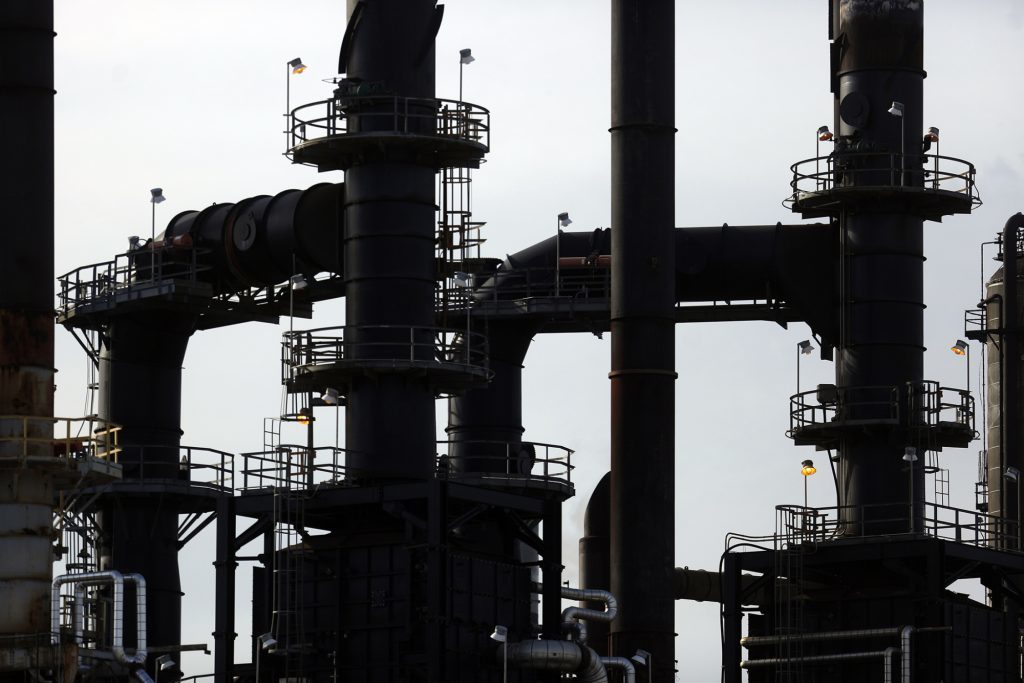
Hurricanes sometimes don’t need to make landfall to cause problems for U.S. refineries.
At least two East Coast refineries are making less gasoline and diesel as rough Atlantic seas hamper the transfer of crude oil from ships to barges for delivery to the facilities, people familiar with operations say.
Philadelphia Energy Solutions Inc., which operates the largest oil-refining complex serving the New York Harbor market, was said to cut rates about 20 percent. Delta Air Lines Inc.’s Monroe Trainer in Pennsylvania ran out of crude and had to put its crude units into circulation limbo, heated but not processing. Unless supply is replenished within a few days, Trainer will run vacuum gasoil through the crude units to keep them running and to provide feedstock for processing units like the fluid catalytic crackers.
“Product prices are rallying in response to refinery run cuts on the East Coast, which will result in lower product availability in the short term,” Andy Lipow, president of Lipow Oil Associates LLC in Houston, said in a phone interview Monday.
Gasoil Use
Using feedstocks like gasoil instead of crude would further limit the amount of fuel a refinery can produce and deplete East Coast inventories that were already run down after Hurricanes Harvey and Irma. Gasoline and diesel futures surged Monday, with diesel reaching a two-year high and gasoline touching levels last seen right after Harvey shut almost a quarter of U.S. refining capacity.
Philadelphia Energy also ordered as many as eight train loads of Bakken crude from North Dakota to supplement crude quickly at its 335,000 barrel-a-day refinery. Crude from the Great Plains is looking more attractive to coastal refiners as U.S. benchmark West Texas Intermediate crude sank to the steepest discount since 2015 to Brent, the international marker. The Trainer refinery was forced to cut rates after running above its 185,000 barrel-a-day nameplate capacity last week.
Adam Gattuso, a Trainer spokesman, couldn’t comment on daily operations, he said in an email Monday. Philadelphia Energy doesn’t comment on day-to-day operations or its commercial activities, Cherice Corley, a spokeswoman, said in an email.
Gasoline for October delivery on the New York Mercantile Exchange rose 3.2 percent Monday, while diesel futures jumped 2.2 percent. In the New York Harbor spot market, gasoline strengthened by 1.37 cents a gallon versus futures, according to Bloomberg data.
Large swells generated by Hurricane Maria are affecting most of the East Coast of the United States, according to the National Hurricane Center advisory at 8am Eastern time Tuesday. At the mouth of Delaware Bay, waves were forecast to build Monday and Tuesday, peaking at about 10 feet on Sept. 27 as Hurricane Maria moves north.
The storm, which devastated Puerto Rico last week, was forecast Monday to graze the North Carolina coast before turning east in the Atlantic. It will create rough seas along the East Coast as it passes. A wave of 3.6 feet was reported at 6 p.m. local time Monday at the mouth of Delaware Bay, according to the National Data Buoy Center’s website. Over the weekend, waves at the buoy, about 30 miles from Cape May, New Jersey, had reached 5.2 feet.
Texas refineries, including Exxon Mobil Corp.’s Beaumont and Total SA’s Port Arthur are still trying to restore normal operations after Harvey’s Aug. 25 landfall.
“Contributing to the price rally is the fact that Texas Gulf Coast refineries haven’t fully restored operations since Hurricane Harvey,” Lipow said.